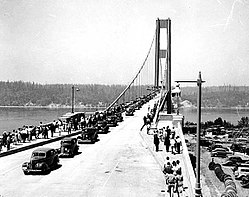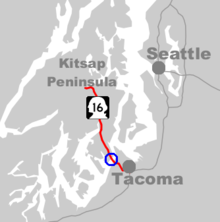
Back Puente de Tacoma (1940) Spanish Pont du détroit de Tacoma (1940) French Jembatan Tacoma Narrows (1940) ID Tacoma Narrows-brúin (1940) Icelandic Tacoma Narrows-broen (1940) NB Katastrofa mostu Tacoma Polish Tacoma Narrows Bridge (1940) SIMPLE Most Tacoma Narrows (1940) Slovenian டகோமா குறும்பாலம் (1940) Tamil
Tacoma Narrows Bridge | |
|---|---|
 The original Tacoma Narrows Bridge on its opening day on July 1, 1940 | |
| Coordinates | 47°16′N 122°33′W / 47.267°N 122.550°W |
| Other name(s) | Galloping Gertie |
| Characteristics | |
| Design | Suspension |
| Material | Carbon steel |
| Total length | 5,939 feet (1,810.2 m) |
| Longest span | 2,800 feet (853.4 m) |
| Clearance below | 195 feet (59.4 m) |
| No. of lanes | 2 |
| History | |
| Designer | Leon Moisseiff |
| Construction start | November 23, 1938 |
| Opened | July 1, 1940 |
| Collapsed | November 7, 1940 |
| Replaced by | Tacoma Narrows Bridge (1950) |
| Location | |
 | |

The 1940 Tacoma Narrows Bridge, the first bridge at this location, was a suspension bridge in the U.S. state of Washington that spanned the Tacoma Narrows strait of Puget Sound between Tacoma and the Kitsap Peninsula. It opened to traffic on July 1, 1940, and dramatically collapsed into Puget Sound on November 7 of the same year.[1] The bridge's collapse has been described as "spectacular" and in subsequent decades "has attracted the attention of engineers, physicists, and mathematicians".[2] Throughout its short existence, it was the world's third-longest suspension bridge by main span, behind the Golden Gate Bridge and the George Washington Bridge.
Construction began in September 1938. From the time the deck was built, it began to move vertically in windy conditions, so construction workers nicknamed the bridge Galloping Gertie. The motion continued after the bridge opened to the public, despite several damping measures. The bridge's main span finally collapsed in 40-mile-per-hour (64 km/h) winds on the morning of November 7, 1940, as the deck oscillated in an alternating twisting motion that gradually increased in amplitude until the deck tore apart. The violent swaying and eventual collapse resulted in the death of a cocker spaniel named "Tubby",[3] as well as inflicting injuries on people fleeing the disintegrating bridge or attempting to rescue the stranded dog.[4]
Efforts to replace the bridge were delayed by World War II, but in 1950, a new Tacoma Narrows Bridge opened in the same location, using the original bridge's tower pedestals and cable anchorages. The portion of the bridge that fell into the water now serves as an artificial reef.
The bridge's collapse had a lasting effect on science and engineering. In many physics textbooks, the event is presented as an example of elementary forced mechanical resonance, but it was more complicated in reality; the bridge collapsed because moderate winds produced aeroelastic flutter that was self-exciting and unbounded: for any constant sustained wind speed above about 35 mph (56 km/h), the amplitude of the (torsional) flutter oscillation would continuously increase, with a negative damping factor, i.e., a reinforcing effect, opposite to damping.[5] The collapse boosted research into bridge aerodynamics-aeroelastics, which has influenced the designs of all later long-span bridges.
- ^ "Tacoma Narrows Bridge collapses". HISTORY. Retrieved 2020-07-12.
- ^ Gianni Arioli and Filippo Gazzola. A new mathematical explanation of what triggered the catastrophic torsional mode of the Tacoma Narrows Bridge. Applied Mathematical Modelling, Jan 2015. doi.org
- ^ "Tacoma Narrows Bridge history - Tubby trivia". www.wsdot.wa.gov. Retrieved 2024-06-04.
- ^ Cite error: The named reference
coatsworthwas invoked but never defined (see the help page). - ^ Cite error: The named reference
BillahScanlan91was invoked but never defined (see the help page).
© MMXXIII Rich X Search. We shall prevail. All rights reserved. Rich X Search